Abstract
Congenital bilateral microphthalmos is a rare malformation of the eye, which ranges from extreme to mild reduction of total axial length. Microphthalmos may occur as an isolated ocular abnormality or as part of a systemic disorder, and different classifications of the condition have been attempted. We describe a large pedigree with 14 persons in four generations affected with bilateral microphthalmos without other ocular or systemic signs. An autosomal dominant trait with complete penetrance is proposed. Five subjects underwent a complete ophthalmological evaluation. The total axial length was measured by A scan ultrasonography in all persons. Ultrasonography showed a reduction of the total axial length (range 18.4-19.7 mm) and a reduced vitreous cavity length (range 11.4-13.5 mm) in all investigated patients. All the patients had microcornea (range 8-9.7 mm). No other ocular anomalies or associated systemic malformations were found. A review of published reports also suggests that simple, partial, posterior, pure microphthalmos and nanophthalmos are similar clinical entities sharing total axial length and vitreous cavity length reduction. Therefore, the term simple microphthalmos is proposed to identify these clinical conditions.
Full text
PDF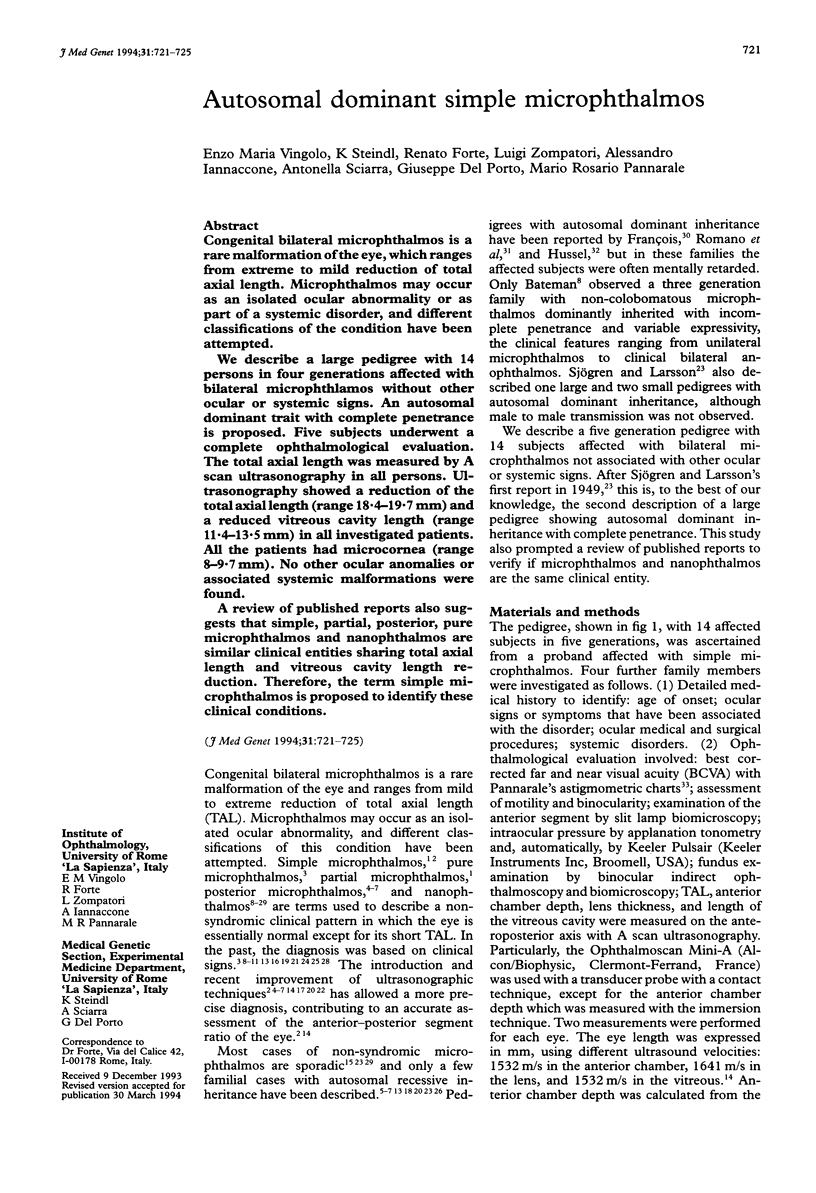
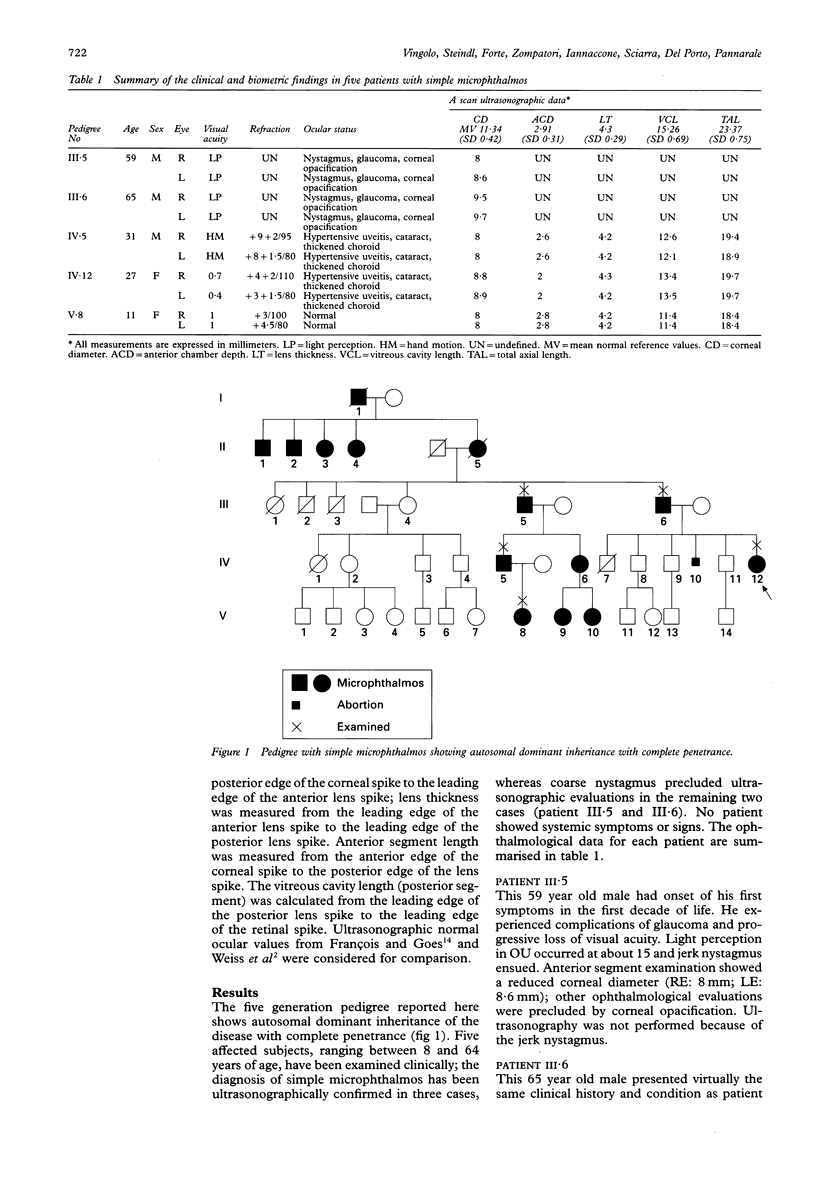
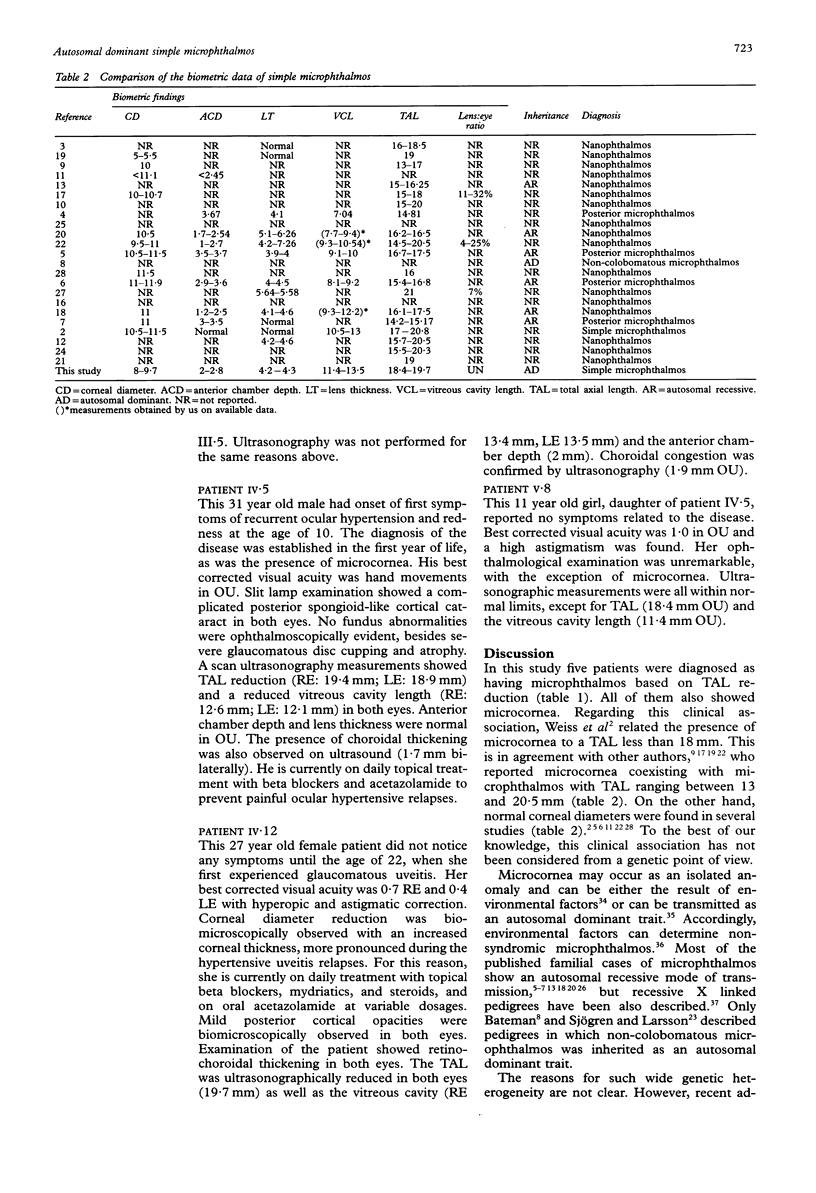
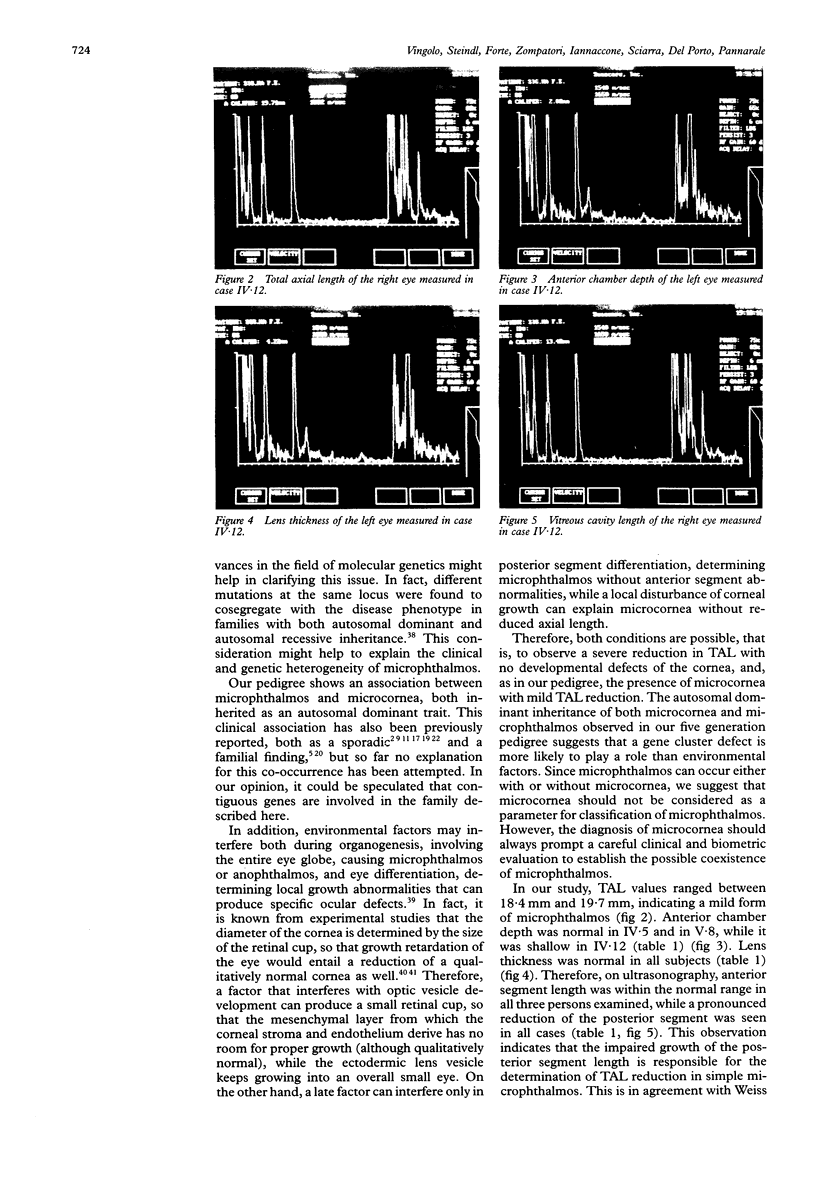
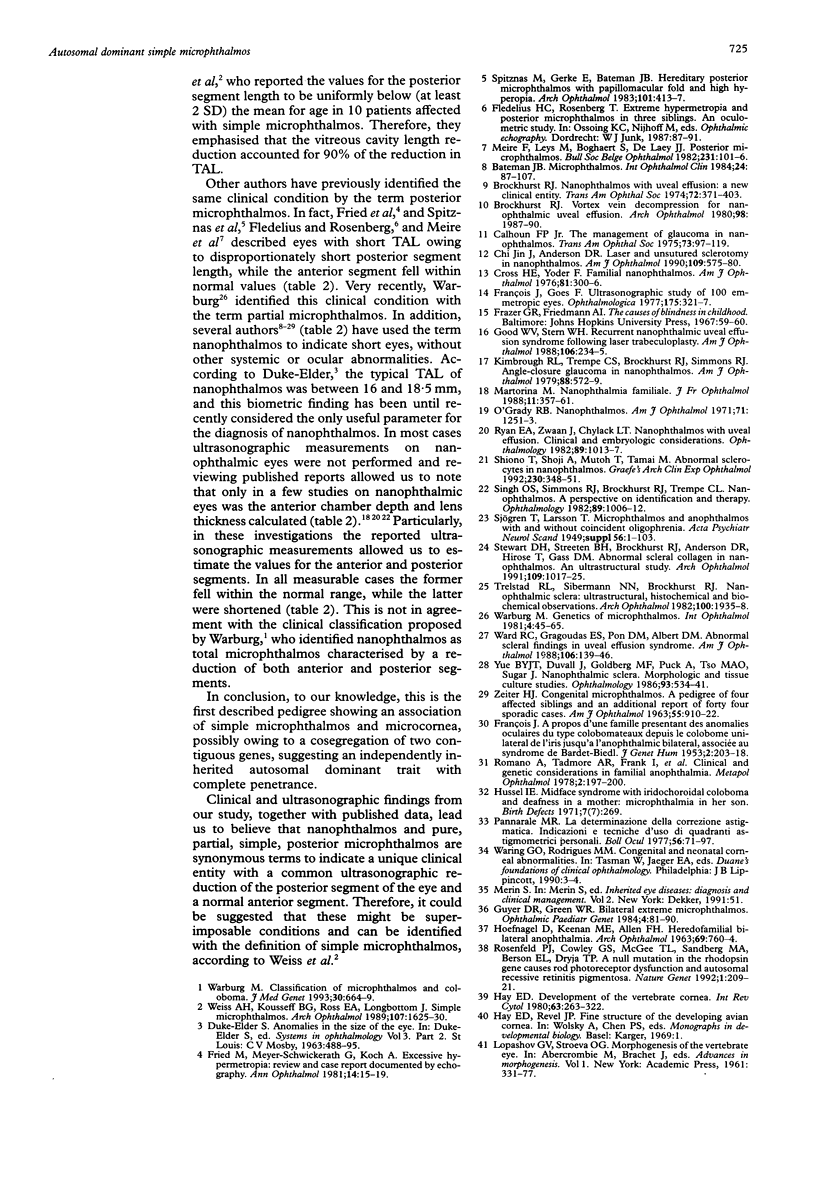
Images in this article
Selected References
These references are in PubMed. This may not be the complete list of references from this article.
- Bateman J. B. Microphthalmos. Int Ophthalmol Clin. 1984 Spring;24(1):87–107. doi: 10.1097/00004397-198402410-00008. [DOI] [PubMed] [Google Scholar]
- Brockhurst R. J. Nanophthalmos with uveal effusion: a new clinical entity. Trans Am Ophthalmol Soc. 1974;72:371–403. [PMC free article] [PubMed] [Google Scholar]
- Brockhurst R. J. Vortex vein decompression for nanophthalmic uveal effusion. Arch Ophthalmol. 1980 Nov;98(11):1987–1990. doi: 10.1001/archopht.1980.01020040839008. [DOI] [PubMed] [Google Scholar]
- Calhoun F. P., Jr The management of glaucoma in nanophthalmos. Trans Am Ophthalmol Soc. 1975;73:97–122. [PMC free article] [PubMed] [Google Scholar]
- Cross H. E., Yoder F. Familial nanophthalmos. Am J Ophthalmol. 1976 Mar;81(3):300–306. doi: 10.1016/0002-9394(76)90244-0. [DOI] [PubMed] [Google Scholar]
- FRANCOIS J. A propos d'une famille présentant des anomalies oculaires du type colobomateux depuis le colobome unilatéral de l'iris jusqu'a l'anophtalmie bilatérale, associée au syndrome de Bardet-Biedl. J Genet Hum. 1953 Dec;2(3-4):203–218. [PubMed] [Google Scholar]
- François J., Goes F. Ultrasonographic study of 100 emmetropic eyes. Ophthalmologica. 1977;175(6):321–327. doi: 10.1159/000308676. [DOI] [PubMed] [Google Scholar]
- Fried M., Meyer-Schwickerath G., Koch A. Excessive hypermetropia: review and case report documented by echography. Ann Ophthalmol. 1982 Jan;14(1):15–19. [PubMed] [Google Scholar]
- Good W. V., Stern W. H. Recurrent nanophthalmic uveal effusion syndrome following laser trabeculoplasty. Am J Ophthalmol. 1988 Aug 15;106(2):234–235. doi: 10.1016/0002-9394(88)90844-6. [DOI] [PubMed] [Google Scholar]
- Guyer D. R., Green W. R. Bilateral extreme microphthalmos. Ophthalmic Paediatr Genet. 1984 Aug;4(2):81–90. doi: 10.3109/13816818409007842. [DOI] [PubMed] [Google Scholar]
- HOEFNAGEL D., KEENAN M. E., ALLEN F. H., Jr Heredofamilial bilateral anophthalmia. Arch Ophthalmol. 1963 Jun;69:760–764. doi: 10.1001/archopht.1963.00960040766015. [DOI] [PubMed] [Google Scholar]
- Hay E. D. Development of the vertebrate cornea. Int Rev Cytol. 1980;63:263–322. doi: 10.1016/s0074-7696(08)61760-x. [DOI] [PubMed] [Google Scholar]
- Hussels I. E. Midface syndrome with iridochoroidal coloboma and deafness in a mother: microphthalmia in her son. Birth Defects Orig Artic Ser. 1971 Jun;7(7):269–269. [PubMed] [Google Scholar]
- Jin J. C., Anderson D. R. Laser and unsutured sclerotomy in nanophthalmos. Am J Ophthalmol. 1990 May 15;109(5):575–580. doi: 10.1016/s0002-9394(14)70689-0. [DOI] [PubMed] [Google Scholar]
- Kimbrough R. L., Trempe C. S., Brockhurst R. J., Simmons R. J. Angle-closure glaucoma in nanophthalmos. Am J Ophthalmol. 1979 Sep;88(3 Pt 2):572–579. doi: 10.1016/0002-9394(79)90517-8. [DOI] [PubMed] [Google Scholar]
- Martorina M. Nanophtalmie familiale. J Fr Ophtalmol. 1988;11(4):357–361. [PubMed] [Google Scholar]
- Meire F., Leys M., Boghaert S., de Laey J. J. Posterior microphthalmos. Bull Soc Belge Ophtalmol. 1989;231:101–106. [PubMed] [Google Scholar]
- O'Grady R. B. Nanophthalmos. Am J Ophthalmol. 1971 Jun;71(6):1251–1253. doi: 10.1016/0002-9394(71)90971-8. [DOI] [PubMed] [Google Scholar]
- Rosenfeld P. J., Cowley G. S., McGee T. L., Sandberg M. A., Berson E. L., Dryja T. P. A null mutation in the rhodopsin gene causes rod photoreceptor dysfunction and autosomal recessive retinitis pigmentosa. Nat Genet. 1992 Jun;1(3):209–213. doi: 10.1038/ng0692-209. [DOI] [PubMed] [Google Scholar]
- Ryan E. A., Zwaan J., Chylack L. T., Jr Nanophthalmos with uveal effusion: clinical and embryologic considerations. Ophthalmology. 1982 Sep;89(9):1013–1017. doi: 10.1016/s0161-6420(82)34686-2. [DOI] [PubMed] [Google Scholar]
- Shiono T., Shoji A., Mutoh T., Tamai M. Abnormal sclerocytes in nanophthalmos. Graefes Arch Clin Exp Ophthalmol. 1992;230(4):348–351. doi: 10.1007/BF00165943. [DOI] [PubMed] [Google Scholar]
- Singh O. S., Simmons R. J., Brockhurst R. J., Trempe C. L. Nanophthalmos: a perspective on identification and therapy. Ophthalmology. 1982 Sep;89(9):1006–1012. [PubMed] [Google Scholar]
- Spitznas M., Gerke E., Bateman J. B. Hereditary posterior microphthalmos with papillomacular fold and high hyperopia. Arch Ophthalmol. 1983 Mar;101(3):413–417. doi: 10.1001/archopht.1983.01040010413014. [DOI] [PubMed] [Google Scholar]
- Stewart D. H., 3rd, Streeten B. W., Brockhurst R. J., Anderson D. R., Hirose T., Gass D. M. Abnormal scleral collagen in nanophthalmos. An ultrastructural study. Arch Ophthalmol. 1991 Jul;109(7):1017–1025. doi: 10.1001/archopht.1991.01080070129050. [DOI] [PubMed] [Google Scholar]
- Trelstad R. L., Silbermann N. N., Brockhurst R. J. Nanophthalmic sclera. Ultrastructural, histochemical, and biochemical observations. Arch Ophthalmol. 1982 Dec;100(12):1935–1938. doi: 10.1001/archopht.1982.01030040915009. [DOI] [PubMed] [Google Scholar]
- Warburg M. Classification of microphthalmos and coloboma. J Med Genet. 1993 Aug;30(8):664–669. doi: 10.1136/jmg.30.8.664. [DOI] [PMC free article] [PubMed] [Google Scholar]
- Warburg M. Genetics of microphthalmos. Int Ophthalmol. 1981 Aug;4(1-2):45–65. doi: 10.1007/BF00139580. [DOI] [PubMed] [Google Scholar]
- Weiss A. H., Kousseff B. G., Ross E. A., Longbottom J. Simple microphthalmos. Arch Ophthalmol. 1989 Nov;107(11):1625–1630. doi: 10.1001/archopht.1989.01070020703032. [DOI] [PubMed] [Google Scholar]
- Yue B. Y., Duvall J., Goldberg M. F., Puck A., Tso M. O., Sugar J. Nanophthalmic sclera. Morphologic and tissue culture studies. Ophthalmology. 1986 Apr;93(4):534–541. doi: 10.1016/s0161-6420(86)33704-7. [DOI] [PubMed] [Google Scholar]
- ZEITER H. J. Congenital microphthalmos. A pedigree of four affected siblings and an additional report of fortyfour sporadic cases. Am J Ophthalmol. 1963 May;55:910–922. [PubMed] [Google Scholar]






